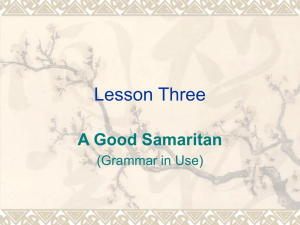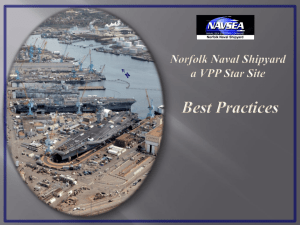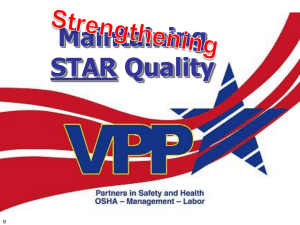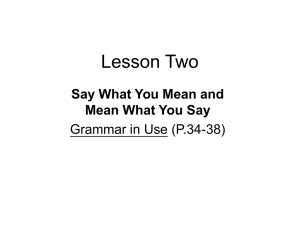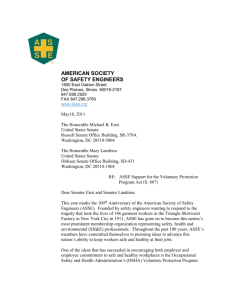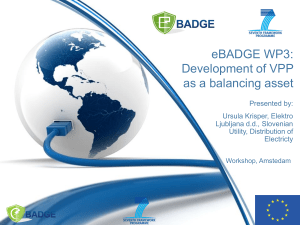Achieving Safety Excellence Through the Voluntary Protection
advertisement
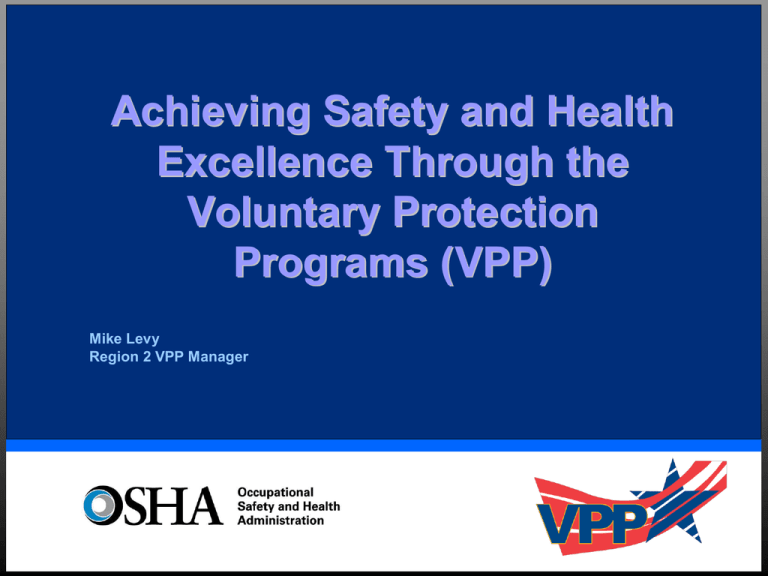
Achieving Safety and Health Excellence Through the Voluntary Protection Programs (VPP) Mike Levy Region 2 VPP Manager OSHA’s Tool Kit Standards Enforcement Education, Training, and Outreach Cooperative Programs Voluntary Protection Programs (Goal is 8,000 sites) Consultation Program and SHARP Strategic Partnerships Alliances OSHA’S 2003-08 GOALS Reduce workplace fatalities by 15% Reduce workplace injuries and illness by 20% Annual Goals Three percent drop in construction fatalities One percent drop in general industry fatalities Four percent drop in injuries and illnesses in construction, general industry, and specific industries with high hazard rates (e.g., landscaping/horticultural services, oil and gas field services, blast furnace and basic steel products, ship and boat building and repair What is VPP? The Voluntary Protection Programs (VPP) are designed to recognize and promote effective safety and health management. In the VPP, management, labor, and OSHA establish a cooperative relationship at a workplace that has implemented a strong program. VPP Concept The VPP concept recognizes that compliance enforcement alone can never fully achieve the objectives of the Occupational Safety and Health Act. Good safety and health management programs that go beyond OSHA standards can protect workers more effectively than simple compliance. Who Participates in VPP? VPP participants are a select group of facilities that have designed and implemented outstanding safety and health programs. Star participants meet all VPP requirements. Merit participants have demonstrated the potential and willingness to achieve Star program status Star Demonstration – special situations and/or industries – equal to Star Three Programs Star Highest level of recognition All VPP requirements met System operating at least one year Rates are below the National Average Three Programs Merit Elements and sub-elements in place Systems may not all be at Star quality Rates may be above the National Average Limited to one 3-year term Three Programs Star Demonstration Must meet Star requirements Alternative safety and health methods Current Demos: Short-term Construction Mobile Workforce Federal Contractor Resident contractor in non-VPP sites RIGHTS AND RESPONSIBILITIES All approved participants in the Voluntary Protection Programs are required to have implemented safety programs and to meet all relevant OSHA standards. Participation will not diminish either employer or employee rights or responsibilities under the Act or Executive Order 12196 for Federal Agencies. Why Pursue VPP?… To Prevent Accidents and Save Money! The average lost-time injury cost $30,000!….. (The National Safety Council) Each heavy construction injury or illness equals 8-9 lost workdays!…….(U.S. Bureau of Labor Statistics) Work injuries cost Americans $131.2 billion in 2000, exceeding the combined profits of the top 13 Fortune 500 companies!….. (The National Safety Council) Accidents It takes a minute to write a safety rule. It takes an hour to hold a meeting. It takes a week to develop a safety program. It takes a month to put it in operation. It takes a year to win a safety award. It takes a lifetime to train a safe worker. It takes one second to destroy it all with one accident. -Author Unknown Why Pursue VPP? Reduced Illnesses and Injuries: On average injury and illness rates at VPP sites are 54% below National averages Cost Savings: VPP sites avoided 5,638 injuries in FY2000 Total cost savings approximately $152 million Other Incentives…VPP Benefits Business Improved employee motivation to work safely, leading to better quality and productivity. Improvement of programs that are already good, through the VPP application process and internal and external reviews. Other Incentives…VPP Benefits Business, cont’d Recognition in the community Competitive edge. Verification of the safety and health management system by OSHA. Reduced injury and illness rates. Reduced workers' compensation costs. VPP Benefits Workers Go home safe Involvement in S&H Pride in work Improved morale VPP Benefits OSHA Partners in excellence Accomplishes OSHA’s mission VPP partners serve as models for their industries Helps OSHA promote value of safety and health Leverages resources Assist in standards development. Provide program resources / mentoring, OSHA volunteers, training, seminars, WTC VPP is a Win-Win-Win Relationship! Trust and cooperation Elimination of fear Achievement of a common goal….to prevent worker injuries, illnesses and deaths Improved relations between labor, management, and government Principles of VPP Focus on individual worksites Performance-based criteria Beyond compliance Self-Sufficient Continuous Improvement Effective safety and health management systems Elements of a Comprehensive Safety and Health Management System Management Leadership and Employee Involvement Worksite Analysis Hazard Prevention and Control Safety and Health Training Will My Program Qualify? A Self-Assessment checklist is included in the VPP information kit. Use the checklist to see if your program meets VPP criteria. The checklist covers information about a site’s Lost Workday Rates, Safety and Health Program elements, and related topics. Where do I sign up? VPP Application Process Companies submit an application that includes: Management assurances Written union support Injury and illness rates Description of safety and health management system Application reviewed for completeness Company’s previous OSHA history verified OSHA and the site prepare for the onsite review What Paperwork is Involved? The application is a summary of the safety and health management system. The focus in not on a single correct way to meet VPP requirements, but rather a system that works. Some successful programs involve a lot of written documentation, while others do not. There is some paperwork required in the application process, but use of existing material is encouraged. What Do Management & Employees Agree To Do? Management agrees to operate an effective program that meets an established set of criteria. Management also agrees to provide OSHA with annual OSHA Log information and an evaluation report. All employees agree to participate in the program and work with management to ensure a safe and healthful workplace. All unions must confirm their support of the application, if applicable. Onsite Evaluation An OSHA Team visits the site Typically lasts 3-5 days Evaluation consists of: Opening Conference Document Review Walkthrough of Worksite Employee and Management Interviews Closing Conference Draft Report and Team’s Recommendations for one of three programs Documentation Review Baseline surveys Hazard analyses Preventive Maintenance records Training records Records of employee involvement Program evaluations Site Tour Follow entire work process where possible Note hazard categories Note needed improvements Suggest improvements – establish timeline for corrections Interviews Formal – to determine the perception of all levels of employees regarding the effectiveness of each element of the safety and health program. Informal – to determine the employees’ knowledge of safety and health procedures and policies. Closing Conference Team recommendation for one of three findings Presentation of site review findings Presentation of draft report Celebration! New approvals by Assistant Secretary Re-approvals at Regional Level VPP Ceremony Continuous Improvement Annual Self-Evaluation On-going dialogue OSHA re-visits the site every three to five years. (12 –18 months for Merit sites) VPP Sites Stay Involved! Program Innovations VPPPA Mentoring Special Government Employees Where Can I Get More Information? The VPP Manager in your Regional Office can provide you with a VPP information kit and help with questions about the program. Mike Levy Office: 518-464-4338 levy.michael@dol.gov Information is also at: www.osha.gov
